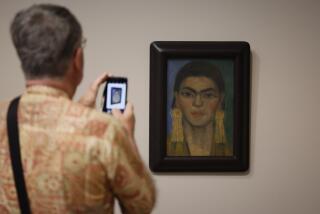Jesse Jackson Responds to Portrait of Him as White
WASHINGTON â Jesse Jackson, viewing for the first time the controversial painting that depicts him as a blond, blue-eyed white man, said, âItâs not the picture thatâs the insult. Itâs the reality behind the picture: Thatâs the insult.â
The portrait, entitled âHow Ya Like Me Now?â by artist David Hammons and part of the Washington Project for the Arts âThe Blues Aestheticâ exhibition, was placed on a street corner Wednesday evening. Just as three white WPA employees completed the installation, a group of about 10 black men took a sledgehammer to the work, knocking a major portion down.
Sunday afternoon, when he toured the exhibition, Jackson saw the bottom section of the work, which shows his face from eyebrows to chin. He made the visit, he said, to encourage the gallery, to encourage artistic expression and to put both the portrait and the reaction to it âin context.â
The âreaction is an extension of the art,â he said. âYou drop a big rock in the water--the issue is not just the rock. Itâs also the ripples. This is a big rock.â
Jackson said he did not personally find the work insulting âbecause I understand it. My response was interpretation and intent. But I understand those that reacted violently. We must appreciate the source of their pain. They must not be painted out of the equation.â
The work, he speculated, provoked a release of anger that sat just beneath the surface. The men who attacked the portrait reacted âwithout inhibitions, without reserve. They said, âThis is an insult.â
âThose that responded without asking âWhat does it mean?â--that was artistic too. Reducing the street saying âIf he were white . . .â to art, to a picture, is one thing. Itâs people feeling a sense of indignity. Suppose their insult level was so low that this did not provoke them?
âLast year I heard, âMan if you were not black, youâd be a cinch,â or âIf you were white, youâd be President.â Well, that is a sinful suggestion because one can only be what God has allowed one to be. In some sense, the artist captured what really is a common saying but a rather humiliating predicament. . . . One should not have to be anything but what one is.â
WPA Board President Jim Fitzpatrick said the work had been displayed inside the gallery for three months while the WPA awaited permission from the city for the outdoor installation, which is on city property. While inside, he said, the work provoked comments but no violence or controversy. Permission to display the work outside was granted early last week.
âAnytime you have a work of art out on the street,â Fitzpatrick said, âyou can touch a very raw nerve.
âThe piece poses two questions,â he said. âIt poses to whites: Can you look past race to an individual? And it poses to blacks: Can you deal with one of the most revered individuals and symbols depicted other than as an icon?â
WPA commissioned âHow Ya Like Me Now?â and works by six other artists for the exhibition, which explores the effect of black culture on contemporary art. Four of the works were intended for public display outdoors.
More to Read
The biggest entertainment stories
Get our big stories about Hollywood, film, television, music, arts, culture and more right in your inbox as soon as they publish.
You may occasionally receive promotional content from the Los Angeles Times.










